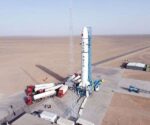Russia’s space program is facing a critical propulsion bottleneck as its legacy rocket engine infrastructure falters under geopolitical pressure and industrial stagnation. With the venerable RD-180 engine no longer exported and domestic production of next-generation engines like the RD-191 lagging behind demand, Roscosmos must now confront a growing crisis in sustaining its orbital launch cadence. This comes as the world marks the 300th mission to the International Space Station (ISS), underscoring how global access to orbit increasingly depends on resilient propulsion supply chains.
RD-180 Phase-Out and Its Strategic Fallout
The Russian-built RD-180 engine—long a linchpin of American Atlas V launches—has reached the end of its export life. Following Russia’s full-scale invasion of Ukraine in 2022, U.S. sanctions halted further procurement of Russian propulsion hardware. United Launch Alliance (ULA) completed its final Atlas V launches using stockpiled RD-180s in 2024. The engine’s retirement from U.S. service marked not only a symbolic decoupling from Russian aerospace but also removed one of Russia’s most lucrative export channels for high-performance liquid-fueled engines.
Originally designed by NPO Energomash in the 1990s as a derivative of the Soviet-era RD-170 family, the RD-180 offered exceptional thrust-to-weight performance via staged combustion using kerosene (RP-1) and liquid oxygen (LOX). However, despite its technical excellence, Russia failed to capitalize on this capability domestically. The country never fielded an operational heavy-lift vehicle using the RD-180 at scale; instead relying on older platforms like Proton-M with different propulsion architectures.
With no new foreign buyers and limited domestic use cases remaining for the engine—especially after cancellation of projects like Angara-A5V variants that might have used it—production lines are being idled or repurposed. Energomash has reportedly shifted focus to other engines like the single-chamber RD-191 series used on Angara rockets.
RD-191 Bottlenecks Undermine Angara Program
The Angara family was intended to replace aging Soviet-era launchers such as Proton-M and Rokot. Central to this effort is the modular use of URM (Universal Rocket Module) stages powered by variants of the single-chamber RD-191 engine—a modernized derivative sharing lineage with both RD-170 and RD-180.
However, production capacity for these engines remains constrained. As recently reported by Russian sources including TASS and Kommersant, Energomash has struggled to meet delivery targets due to supply chain issues exacerbated by sanctions on precision components and materials. The Peresvet machine-building plant in Perm—responsible for key turbopump assemblies—has faced delays that ripple across final assembly timelines.
This bottleneck has already impacted launch schedules for Angara-A5 missions from Plesetsk Cosmodrome and Baikonur’s new Vostochny site. In particular:
- The planned serial production ramp-up beyond two launches per year remains unfulfilled.
- Military payloads destined for geostationary orbit under Ministry of Defence contracts have been delayed or reassigned.
- The absence of reliable heavy-lift alternatives weakens Russia’s ability to deploy large ISR or early-warning satellites independently.
Aging Infrastructure at Energomash Threatens Long-Term Viability
NPO Energomash’s facilities in Khimki near Moscow remain largely reliant on Soviet-era tooling and manufacturing practices. Despite periodic modernization efforts—including CNC upgrades funded during peak U.S.-RD180 collaboration years—the plant faces systemic challenges:
- Loss of skilled labor due to demographic decline and emigration post-war mobilization efforts.
- Inability to source Western-grade electronics or high-performance alloys due to export controls.
- Lackluster investment from Roscosmos amid budgetary constraints prioritizing crewed flight over infrastructure renewal.
This situation mirrors broader trends across Russia’s defense-industrial base where legacy capabilities are proving difficult to sustain without foreign capital or technology access. While China has expressed interest in joint development programs—including potential co-production agreements for methane-fueled engines—no formal contracts have materialized as of mid–2025.
Implications for Military Space Access
The inability to reliably produce medium-to-heavy lift launch vehicles directly affects Russia’s military space posture:
- SIGINT/ELINT Satellites: Platforms such as Liana (Lotus-S1/S1M) require precise orbital insertion profiles that only heavier launchers can provide efficiently.
- Nuclear Command & Control: Continuity-of-government satellites like Raduga-class relays depend on timely replenishment which is now at risk due to launcher scarcity.
- ASAT Testing: While ground-launched interceptors remain active under programs like Nudol/PL19, any kinetic ASAT demonstration requiring target satellites may be deferred without assured access-to-orbit capabilities.
This degradation contrasts sharply with NATO-aligned nations’ increasing investments into responsive space access via commercial providers such as SpaceX (Falcon Heavy), Arianespace (Ariane 6), or Japan’s H3 program—all offering diversified propulsion supply chains insulated from geopolitical disruption.
The ISS Milestone Highlights Diverging Trajectories
The recent milestone—the 300th mission supporting operations aboard the International Space Station—serves as a reminder of both cooperation history and divergent futures in human spaceflight logistics. While Soyuz remains operationally reliable for crew rotation missions through at least 2028 under current agreements, NASA has shifted primary reliance toward commercial crew services via SpaceX Crew Dragon capsules launched aboard Falcon 9 boosters from Florida’s Kennedy Space Center.
This shift reduces dependency on Russian systems while enabling higher cadence launches with greater schedule autonomy—a capability Roscosmos cannot currently match given its strained industrial base. Moreover, future crewed platforms such as China’s Tiangong station or NASA’s Artemis Gateway will likely exclude Russian participation entirely unless significant reforms occur within Roscosmos’ procurement model and technological ecosystem.
Conclusion: Strategic Decay Without Reform
Russia’s rocket engine predicament illustrates how even technically advanced legacy systems can become strategic liabilities when industrial resilience erodes amid geopolitical isolation. Without meaningful investment into modernized manufacturing capacity—and diversification beyond state-run monopolies like Energomash—the nation risks ceding not just commercial launch market share but core military-space competencies vital for national security autonomy.
If no course correction occurs within this decade, Russia may find itself increasingly dependent on foreign partners—or relegated entirely—to suborbital roles within multipolar space competition dominated by agile private-sector players backed by robust state-industrial ecosystems elsewhere in Asia, Europe, and North America.









